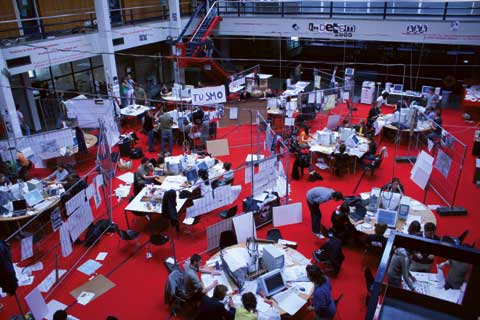At this year’s international design seminar Indesem, students had to design buildings for two of Belgium’s extreme political parties.
For students participating in the international design seminar Indesem, organized by TU Delft’s architecture student association Stylos, the design task was daunting: Take a plot of land in Antwerp, Belgium and design new headquarters for Belgian’s Flemish nationalist party Vlaams Belang, and for Vlaams Belang’s extreme Islamic opponent, the AEL (Arabic European League).
How should architects operate in such political, ethnic or religious matters? Is architecture ‘neutral’ and only about aesthetics or is it acceptable that buildings propagate implicit or explicit messages? Can architects help bridge the gap between different ethnic and socio-political groups?
These and other questions had to be answered by the students, half of whom were Dutch, and half from abroad . mainly from Eastern Europe, Turkey and Canada. This year’s workshop theme appealed to the student architects. In Europe, multiculturalism’s the hot issue and religious extremism dominates media headlines around the world.
Indesem showed that the younger generation certainly has ideas about architecture’s political and social role. The ideas presented however weren’t limited by ‘standard’ ideologies of the past and didn’t easily fit in schemes of left versus right, progressive versus conservative, good versus bad.
Cage
The jury, headed by TU Delft assistant professor Deborah Hauptman, selected three winning concepts that will be published in the architecture magazine, ‘A10’. In one winning design, the Vlaams Belang party headquarters was presented as a cage within a cage, safe against bomb attacks, with a system of several security gates architecturally representing the party’s extreme right-wing ideas.
For the Islamic AEL headquarters, the same group proposed a design of the building as a ‘sunken square’, with a bunker in it, creating great tension with the public square in front of the building.
“Whatever way you design or build as an architect, you make implicit or explicit choices,” Hauptman said. “To be able to make those choices, you have to define your own position, moral values and ethical considerations. And you should at least try to evaluate the social and political consequences of your choices. Not an easy job, since morality is not well defined and sometimes controversial.”
Another interesting concept was that of a flexible building with separate parallel rooms, with the different groups in society being assigned separate rooms according to a ‘party’ calendar. Since these groups don’t mix anyway – a strong statement in itself . they’d all want their own space. Hope, however, was offered in the democratic way the building constantly would adapt itself to the needs of all distinct groups.
By taking two extreme political parties as its subject, the Indesem seminar impressed upon students the social and political impact implicit in architectural design. As one student put it, “There is a thin line between being radical, cynical, and naive. This is exactly the thin line architects walk on all the time.”
Indesem participants at work. (Photo: Peter Rieff)
For students participating in the international design seminar Indesem, organized by TU Delft’s architecture student association Stylos, the design task was daunting: Take a plot of land in Antwerp, Belgium and design new headquarters for Belgian’s Flemish nationalist party Vlaams Belang, and for Vlaams Belang’s extreme Islamic opponent, the AEL (Arabic European League).
How should architects operate in such political, ethnic or religious matters? Is architecture ‘neutral’ and only about aesthetics or is it acceptable that buildings propagate implicit or explicit messages? Can architects help bridge the gap between different ethnic and socio-political groups?
These and other questions had to be answered by the students, half of whom were Dutch, and half from abroad . mainly from Eastern Europe, Turkey and Canada. This year’s workshop theme appealed to the student architects. In Europe, multiculturalism’s the hot issue and religious extremism dominates media headlines around the world.
Indesem showed that the younger generation certainly has ideas about architecture’s political and social role. The ideas presented however weren’t limited by ‘standard’ ideologies of the past and didn’t easily fit in schemes of left versus right, progressive versus conservative, good versus bad.
Cage
The jury, headed by TU Delft assistant professor Deborah Hauptman, selected three winning concepts that will be published in the architecture magazine, ‘A10’. In one winning design, the Vlaams Belang party headquarters was presented as a cage within a cage, safe against bomb attacks, with a system of several security gates architecturally representing the party’s extreme right-wing ideas.
For the Islamic AEL headquarters, the same group proposed a design of the building as a ‘sunken square’, with a bunker in it, creating great tension with the public square in front of the building.
“Whatever way you design or build as an architect, you make implicit or explicit choices,” Hauptman said. “To be able to make those choices, you have to define your own position, moral values and ethical considerations. And you should at least try to evaluate the social and political consequences of your choices. Not an easy job, since morality is not well defined and sometimes controversial.”
Another interesting concept was that of a flexible building with separate parallel rooms, with the different groups in society being assigned separate rooms according to a ‘party’ calendar. Since these groups don’t mix anyway – a strong statement in itself . they’d all want their own space. Hope, however, was offered in the democratic way the building constantly would adapt itself to the needs of all distinct groups.
By taking two extreme political parties as its subject, the Indesem seminar impressed upon students the social and political impact implicit in architectural design. As one student put it, “There is a thin line between being radical, cynical, and naive. This is exactly the thin line architects walk on all the time.”
Indesem participants at work. (Photo: Peter Rieff)



Comments are closed.